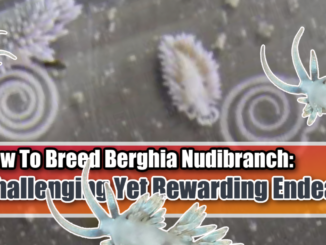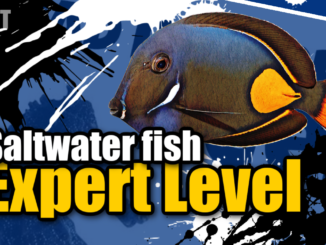
Berghia nudibranch, scientifically known as Bergies., is a type of sea slug or nudibranch that belongs to the family Aeolidiidae. These creatures are well-known for their striking appearance and unique behavior, as they are often sought after by reef tank keepers for their ability to control populations of pest anemones known as aiptasia, in reef tanks.
Aiptasia Eatting Berghia Nudibranch Care
Caring for Aiptasia-eating Berghia nudibranchs involves providing the right environment, food source, and proper tank conditions to ensure their health and effectiveness in controlling pest anemone populations in your reef aquarium.
Berghia Nudibranch Eatting Aiptasia Video Clip
Berghia Nudibranch Care:
- Dedicated Tank: It’s recommended to have a separate tank dedicated to Berghia nudibranchs, especially if you’re introducing them solely for Aiptasia control.
- Water Parameters: Maintain stable water parameters similar to those found with normal reef tank parameters. This includes proper salinity, temperature, pH, and water flow. Regular water testing and maintenance are essential.
- Substrate and Hiding Places: Provide suitable substrate and hiding spots for the nudibranchs. They will lay their eggs on various surfaces, so having rocks or other structures in the tank is beneficial.
Food and Feeding:
- Aiptasia Anemones: The primary food source for Berghia nudibranchs is Aiptasia anemones. Ensure a consistent and ample supply of Aiptasia in the tank. You can introduce small Aiptasia to the tank to encourage the nudibranchs to feed.
- Observation: Monitor the nudibranchs’ feeding behavior to ensure they are actively consuming Aiptasia. As their primary diet, a steady supply of Aiptasia is necessary for their survival.
Compatibility and Care:
- Avoid Overstocking: Keep in mind the population density of nudibranchs in relation to the available Aiptasia. It’s essential to maintain a balance to prevent either excessive Aiptasia or inadequate food supply for the nudibranchs.
- Water Quality: Ensure excellent water quality by performing regular water changes and using quality filtration equipment. Poor water quality can stress the nudibranchs and compromise their health.
- Predators: Be cautious of potential predators that may consume the nudibranchs. Fish (especially wrasses), crabs, and other invertebrates could view the nudibranchs as prey.
- Handling: Handle nudibranchs with care if you need to move them. Their delicate structures are sensitive to rough handling. I like to use a 3ml pipette with the tip cut off to handle the nudibranchs.
Patience and Monitoring:
- Growth and Reproduction: Berghia nudibranchs reproduce by laying eggs, which hatch into planktonic larvae. Successful breeding and reproduction can lead to a growing population of nudibranchs that can continue to control Aiptasia over time.
- Population Control: It’s important to maintain a suitable number of Berghia nudibranchs to ensure effective Aiptasia control without depleting the food source entirely.
- Observation: Regularly observe the behavior of both the nudibranchs and the Aiptasia to assess the effectiveness of their interaction.
Remember that Berghia nudibranchs have specialized care requirements and their primary purpose in the reef aquarium is pest control. If you’re introducing them to an existing reef tank, be sure to consider the compatibility of other tank inhabitants and the potential impact on your overall ecosystem.
Key characteristics of Berghia nudibranchs include:
- Appearance: Berghia nudibranchs are relatively small, usually ranging from about 1 to 2 inches (2.5 to 5 centimeters) in length. They have a translucent body with vibrant colors, such as orange, red, or purple. They lack a shell, which is a defining feature of nudibranchs, and instead have a series of cerata (finger-like structures) on their back that house their digestive and respiratory systems.
- Feeding Habits: Berghia nudibranchs are primarily predators that feed exclusively on a group of pest anemones known as Aiptasia spp. These anemones can become invasive in marine aquariums, causing harm to other tank inhabitants and disrupting the overall balance of the ecosystem. Berghia nudibranchs have evolved to specialize in consuming these pest anemones, making them valuable allies for aquarium hobbyists seeking a natural solution to control Aiptasia populations.
- Lifecycle: The life cycle of Berghia nudibranchs includes several stages. They go through egg, larval, and adult phases. The eggs are usually laid in spiral clusters, and the hatched larvae drift in the water column, undergoing metamorphosis before settling down on a substrate. As they grow, they feed on Aiptasia anemones, Breeding Berghia Nudibranchs can be fun and profitable.
- Aquarium Care: While Berghia nudibranchs can be beneficial in controlling Aiptasia populations, they require specific care requirements. Proper aquarium conditions, appropriate food sources (Aiptasia anemones), and compatibility with other tank inhabitants should be considered before introducing them to a marine aquarium. It’s important to note that Berghia nudibranchs may not consume other types of anemones or corals, so their diet is highly specialized.
It’s worth mentioning that while Berghia nudibranchs can be effective in controlling Aiptasia, their availability can be limited, and they may not completely eliminate the pest anemones in a large and complex aquarium setup.
As with any addition to an aquarium ecosystem, careful research and consideration are essential to ensure the well-being of all inhabitants.
Are you a Maine based hobbyist? Our retail store Corals Unlimited is maine aquarium store located in Topsham, Maine.




